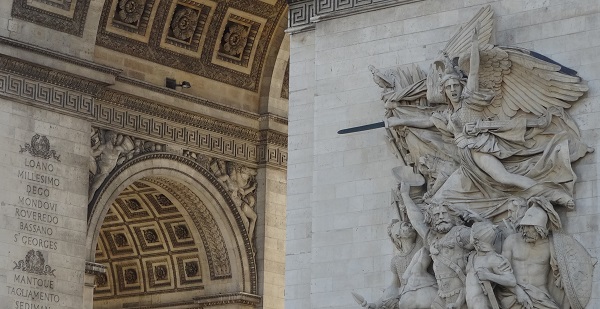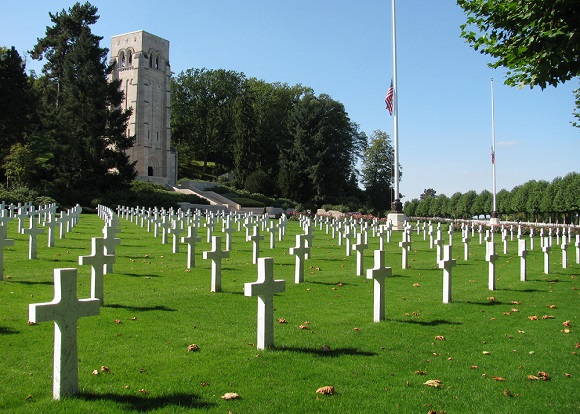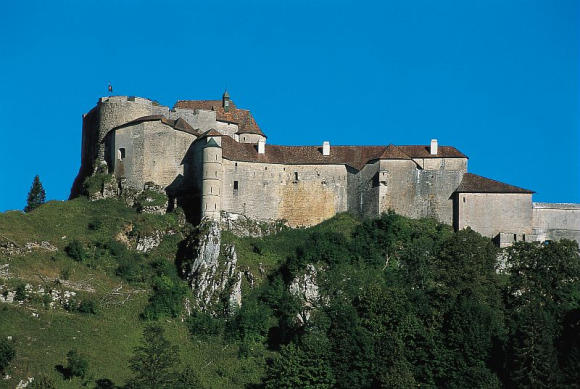
The France Revisited Newsletter
December 10, 2018
Dear Friends, Readers and Travelers,
I write this in the wake of two major events in Paris over the past month that occurred by the Tomb of the Unknown Soldier at the Arc de Triomphe:
1/ On Nov. 11, the gathering of leaders of the belligerent nations of the First World War to commemorate the centennial of the armistice.
2/ On Dec. 1, the vandalization of the arch by some affiliated with the Yellow Vest movement.
It’s no coincidence that both events took place at the same highly symbolic site since each of those involved individuals holding different visions of the future of national and international institutions.
Close-up images of burning cars may be impressive, but planning violence by setting out early in the day with bocce balls in your backpack rather than an AK-47 and 50 rounds nearly seems quaint from an American point of view. Anyway, those Yellow Vests who arrived in the capital intent on destruction can’t be considered as defining the entire movement. The many who say that it’s time to “take our country back” and end the current presidency because they say so are likely more representative, with many earnest earning- and tax-related gripes, complaints and frustrations in the mix.
Parisians want to feel safe, of course. And we do—safe, secure, well-fed. Visitors should too; they may just need to turn to guidance (e.g. the hotel receptionist) to know where not to venture on a demonstration day. Personally, I’m looking forward to a visitor-filled holiday season. As to travel through the rest of France, slow traffic on a partially blocked route is the main risk—and yet another good reason to take to country roads.
Still, between the centennial commemorations and the vandalization of the Arc de Triomphe, not to mention Yemen, Saudi assassination teams, global warming and whatever the Russians are now up to, I’ve decided to make this a 5-part newsletter on the theme of war.
France Revisited is not, however, a place for pessimism. Travel means learning and wars are historical events that we can learn from. Rest assured, this newsletter also speaks of champagne for the holidays, bratwurst for Batignolles and some exceptional French cuisine for your Paris restaurant list.
Here’s the newsletter war strategy.
Part 1. Over There: WWI Sights of the American Meuse-Argonne Offensive
Part 2. Belleau Wood, the War on History and Peaceful Champagne with Gary on Dec. 14
Part 3. Paris’s New WWI Memorial
Part 4. The War on Slavery: The Abolition Route in eastern France
Part 5. Hanukkah and the War of the Maccabees (an Excuse)

Part 1. Over There: WWI Sights of the American Meuse-Argonne Offensive
The First World War left its mark throughout the department of Meuse in northeast France, from Saint Mihiel to Verdun to the Argonne Forest. This article, including three videos, examines several sights relative to the Meuse-Argonne Offensive of the U.S. First Army in the fall of 1918: the Meuse-Argonne American Cemetery in Romagne-sous-Montfaucon, Romagne 14-18, the Romagne German Cemetery and the Montfaucon Monument. It also provides information about visiting other WWI sights in and on the edge of Meuse, along with hotel and B&B suggestions.

Part 2. Belleau Wood, the War on History and Peaceful Champagne with Gary on Dec. 14
No sitting U.S. president has ever visited Belleau Wood, the Aisne-Marne Cemetery and the American Monument at Chateau-Thierry, which are among the most significant American WWI sights in France. In planning for U.S. President Donald Trump to the visit Belleau Wood and the cemetery that it overlooks last month, the State Department and president-watchers of all tendencies were well aware that this was to be an exceptional occasion. Extreme precautions were made to ensure that, rain or shine, it all went off without a hitch: the photo op, the clear, simple speech, etc. The point, of course, was not for the president himself to get a tour of those sights, but for Americans at home and abroad to bear witness—and therefore participate—in his honoring of fallen countrymen and the connection between their deaths, our participation in the war, and our country today.
Cancelling the visit on a day of light rain robbed Americans of that opportunity. A president’s indifference became the indifference of American citizens. Consider it a battle won by those waging a war on our own history. But here’s the catch: you have to know what you’ve been robbed of in order to know what’s missing.
To understand the harm of the cancelled visit, try to imagine the WWII Normandy American Cemetery and Pointe du Hoc without a visiting U.S. president making a speech about how America is greater and the world better off for what happened there. You can’t. That’s because a major reason that millions of Americans feel connected enough with D-Day and U.S. involvement in the Second World War to travel to Normandy is because of Reagan’s presence in 1984, Clinton’s in 1994, Bush’s in 2004, and/or Obama’s in 2014—and Private Ryan’s in 1998.
Some of those presidents you despise, others you admire. But it’s neither that admiration or contempt that led you to Normandy; it’s the fact that their very presence focused attention on a time and a place and made it seem important, significant, moving, worthy of attention and of a 3-hour trek from Paris, rain or shine. You felt in one way or another that those sights belonged to you, no matter which president gave the speech, as long as it was given.
We have collectively now been robbed of an opportunity to feel that connection with these World War I sites. But individually you can still go. One possibility is to join me on December 14, when I’ll be leading a small group or groups from Paris to the area of the president’s cancelled visit, an hour away. In the morning we’ll visit the war sights, followed by a delicious lunch with champagne tasting. In the afternoon we’ll visit two champagne producers in the area. For those who live in Paris, you’ll be able to stock up inexpensively on champagne for the holidays.
Let me know as soon as possible if you’d like to join. The cost of the daytrip (including transportation, lunch, tastings and tours) is 270 euros per person, 520 euros for two. The first two people who can tell me the color of the cat with respect to this newsletter get 25 euros off for this week’s trip.
I’ll also be repeating this trip several times in the spring.
![Departure of the Hairy Ones [the nickname for French soldiers during WWI], August 1914, by Albert Herter. GLK.](https://francerevisited.com/wp-content/uploads/GaredelEst-Herter.jpg)
Part 3. Paris’s New WWI Memorial
Traveling through the countryside of France you’ve undoubtedly noticed some of the 30,000 monuments honoring those who “died for France” during the First World War, with the names of local citizens inscribe on them. Paris never had such an inscribed monument, perhaps because of the sheer number of those killed during or as a result of the war: 94,415 Parisians in all have been identified, based primarily on lists drawn up in each arrondissement in the years following the war.
The centennial was the occasion for the City of Paris to rectify that by erecting a 306-yard long memorial plaque on which is inscribed the names of each individual. Inaugurated on Nov. 11, it can be seen on the outer wall of Père Lachaise Cemetery along Boulevard de Ménilmontant.
The two major national monuments in Paris paying homage to soldier killed during the war are the above-mentioned Tomb of the Unknown Soldier beneath the Arc de Triomphe and the little-noticed monument To the Glory of the French Army 1914-1918 at Trocadero. One might add to that list the vast painting entitled Departure of the Hairy Ones [the nickname for French soldiers during WWI], August 1914, at the Gare de l’Est train station. It is the work of the American artist Albert Herter.

© CRT Bourgogne-Franche-Comté
Part 4. The War on Slavery: The Abolition Route in Eastern France
Slavery is a crime against humanity. So decreed France in 2001, making it the first country to do so. What may seem to be a solely symbolic decree, akin to declaring the Jurassic era over, is actually a way of condemning the country’s own history with respect to slavery. Honoring the victims of slavery and the slave trade as well as major abolitionist figures of the 18th and 19th centuries, two dozen sites in eastern France and Switzerland form a constellation known as the Abolition of Slavery Route. This article concerns several of those sites in the Burgundy – Franche-Comté region in central eastern France.

Part 5. Hanukkah and the War of the Maccabees (an Excuse)
I’m sending this message at the end of Hanukkah, the Jewish wintertime festival of lights. The holiday celebrates the rededication of the Temple in Jerusalem by Maccabean Jews after its desecration by Syrian-Greeks. There’s nothing French about Hanukkah, but it’s the opportunity for me to recall what Jews enjoy saying that nearly all Jewish holiday are about: They tried to kill us, we survived, let’s eat.
And that, dear readers, is my timely excuse to end all this talk of war with recommendations for three Paris restaurants, recently tested.
Café Biergit. There’s been a little bit of Berlin in Batignolles (17th arr.) ever since the cheerful Café Biergit opened its doors last May. The bratwurst and currywurst are imported from Germany, as are the bar’s 60 Rhine-style beers. Potato salad and apfelstrudel as well… totally gemütlichkeit! All dishes under 14€. Open daily. (As recommended by Corinne LaBalme.)
Le Nom m’échappe translates as “The name escapes me” and I forgot it myself after first eating there a couple of years ago. But I returned last week and enjoyed the evening so much that I am certain not to forget it again. The tight seating at this welcoming restaurant by the Bourse (2nd arr.) makes it feel like a private club in which to partake in chef-owner Damien Moeuf’s elegant bistro cuisine. Forthcoming don’t-hesitate-to-ask-questions service is provided by his wife Catherine Moeuf and young waiter/natural wine adviser Fred (offered in fluent English, if necessary). Prices: 2 and 3 courses at lunch 19 or 23€, 2 or 3 courses at dinner about 38 and 50€, respectively, plus beverages. Closed weekends.
Kei. If Kei Kobayashi’s name sounded more French to our ears I suspect that his 2-star Michelin restaurant would have more English-speaking clients. As it is, he has lots of Japanese clients along with a faithful French clientele. While his restaurant is infused with the Japanese sense of precision and exquisite design, it also bears all of the hallmarks of the heights of French gastronomy. For whatever his passport, Kobayashi is an exceptional French chef. His cuisine is presented exclusively through a selection of fixed-price tasting menus, at lunch from 58 to 199€, at dinner from 110 to 220€, without beverages. Closed Sun. and Mon. An article about Kei Kobayashi and his restaurant near Les Halles (1st arr.) will be published on France Revisited this winter.
Please let me know as soon as possible if you’d like to join on the December 14 Belleau Wood, WWI and champagne daytrip from Paris.
You spotted the cat, didn’t you?
Happy travels always,
Gary
Gary Lee Kraut
Editor, France Revisited

